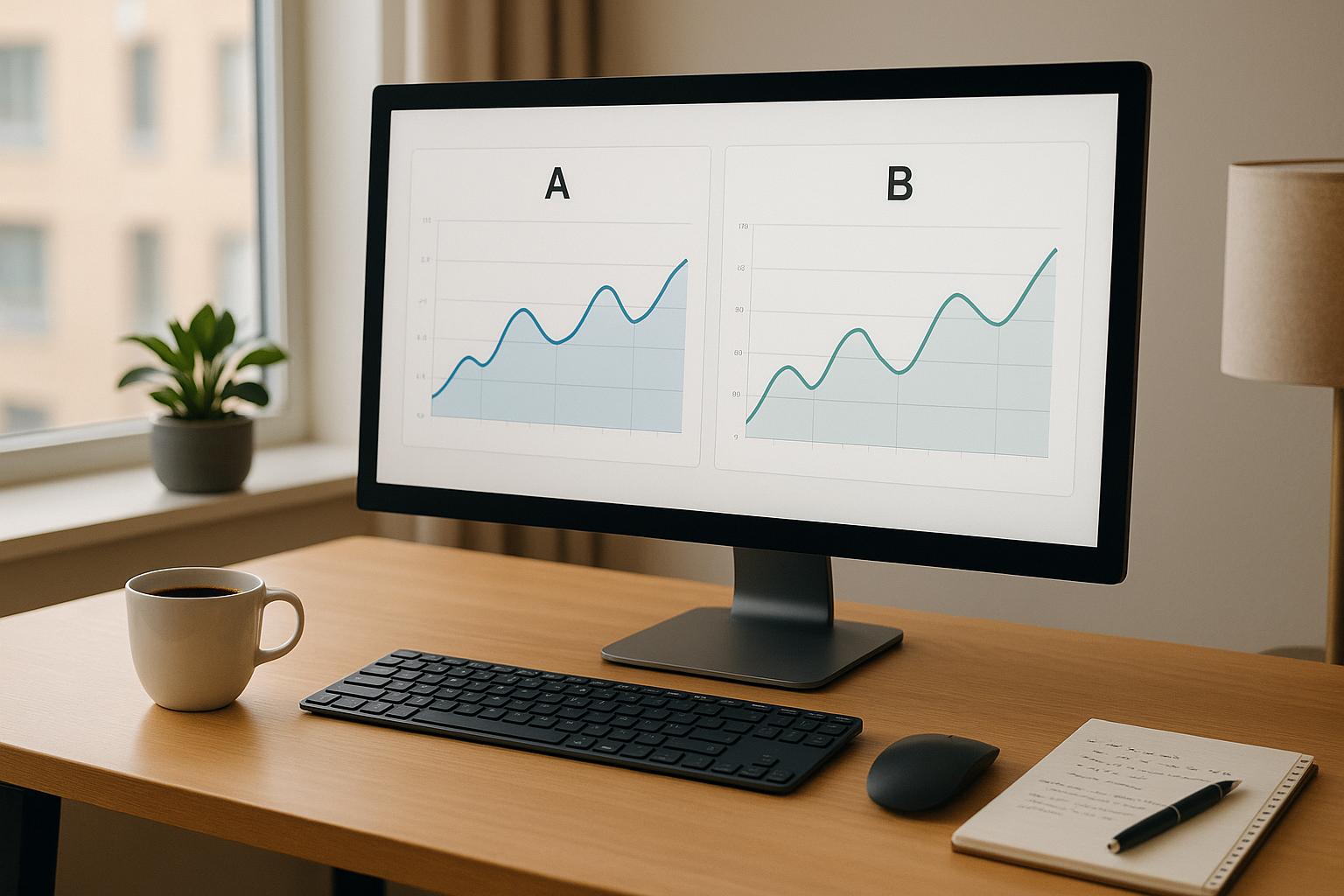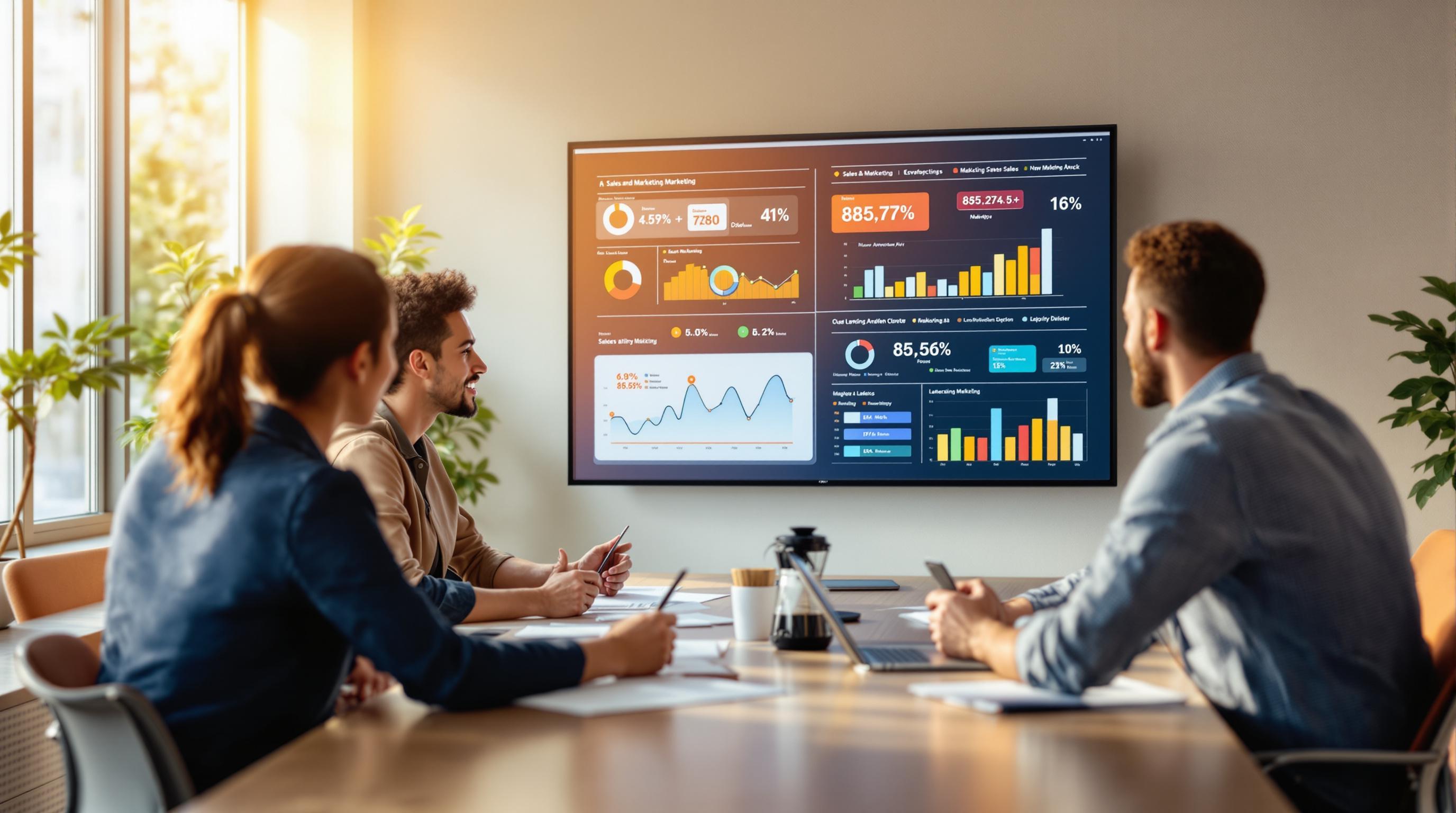Statistical significance in A/B testing helps you determine if the results of your test are real or just random chance. It’s a way to make sure the changes you see - like higher conversions or click-through rates - are worth acting on.
Here’s what you need to know upfront:
- Statistical Significance: Results are often considered valid when there’s less than a 5% chance (p-value < 0.05) that they happened randomly.
- Key Factors: Larger sample sizes, longer test durations, and a 95% confidence level are essential for reliable results.
- P-Values: A lower p-value means stronger evidence against the null hypothesis (the idea that nothing changed).
- Common Pitfalls: Avoid stopping tests too early or relying on misleading results due to small sample sizes.
- Practical Use: Statistical significance ensures your A/B tests lead to data-backed decisions and measurable improvements.
Want to get it right? Use proper tools, calculate sample sizes, and focus on meaningful changes that align with business goals.
Core Elements of Statistical Significance
Understanding P-Values
P-values help determine whether the differences observed in a test are due to random chance or actual variation. As explained in Netflix's Technology Blog, "The p-value is the probability of seeing a result as extreme as our observation, if the null hypothesis were true".
A lower p-value suggests stronger evidence against the null hypothesis. In practical terms, results are often deemed statistically significant when the p-value is below 0.05 - indicating there's less than a 5% chance the result occurred randomly.
Here’s how varying significance levels impact false positive rates:
| Significance Level | False Positive Rate |
|---|---|
| 80% | 1 in 5 tests |
| 95% | 1 in 20 tests |
| 99% | 1 in 100 tests |
This makes selecting the appropriate significance level crucial for interpreting results accurately.
Confidence Levels Explained
Confidence levels reflect how certain you can be about your test results, but higher levels come with wider confidence intervals.
"Confidence intervals are a useful tool for visualizing the uncertainty of data from A/B tests. They help decision-makers assess the risk they'll take by committing to a certain action." – Georgi Georgiev
Commonly used confidence levels include:
- 90%: Useful for quicker insights but with less certainty.
- 95%: Balances accuracy and practicality, making it the most widely used.
- 99%: Offers the highest certainty but requires more data.
Organizations with rigorous testing standards often report win rates between 8% and 30% when adhering to strict confidence levels.
Required Sample Sizes
Accurate sample size calculation is a cornerstone of reliable testing. It ensures results are statistically meaningful by factoring in the baseline conversion rate, the minimum detectable effect, and the desired statistical power (usually set at 80%).
"Sample Size is important in A/B Testing for obtaining statistically significant and reliable test results, allowing you to draw meaningful conclusions and make informed decisions based on the test outcomes." – Usman Adepoju
To gather sufficient data and account for variations like daily or seasonal trends, tests typically need to run for 2–6 weeks. Proper planning here avoids misleading results and ensures actionable insights.
A/B Testing & Statistical Significance - 4 Steps to Know How to Call a Winning Test
Statistical Significance Across Marketing Funnel Stages
Building on the earlier discussion of statistical significance, each stage of the marketing funnel calls for unique testing parameters to achieve measurable outcomes. Adjustments to significance thresholds and sample sizes are essential, as these factors depend on the traffic levels and conversion goals specific to each stage.
Top Funnel Testing
During the awareness stage, the high volume of traffic allows for quicker testing cycles. However, maintaining statistical validity is still crucial. Metrics like click-through rates and engagement serve as early indicators of success. Luke Perry, a CRO expert at Convertcart, highlights the importance of this stage:
"In the awareness stage, TELL shoppers about your USPs to help them discover products and like your brand."
When testing elements at the top of the funnel, it's important to set clear significance thresholds and ensure that tests run long enough to collect representative data. Once these insights are gathered, the focus shifts to nurturing potential leads in the middle funnel.
Middle Funnel Testing
The middle funnel is all about nurturing visitors and turning them into leads, even though conversion rates tend to be lower at this stage. Mike Hale, a UX specialist at Convertcart, advises:
"In the interest stage, you need those website visitors to turn into leads, so come up with compelling copies and visuals that set you apart from other stores."
Testing in this stage requires stricter significance standards due to its impact on generating qualified leads. Key considerations include:
- Evaluating the effectiveness of email sequences with the right confidence levels.
- Testing landing pages to ensure they align with regular traffic behaviors.
- Providing adequate exposure to lead magnet variations to ensure accurate results.
Bottom Funnel Testing
By the time you reach the bottom of the funnel, the stakes are higher, and traffic volumes are lower, making rigorous statistical controls a necessity. This stage focuses on driving revenue, and even minor adjustments can have a big impact. Mike Hale from Convertcart points out:
"The action stage is focused on making shoppers click on the call-to-action (CTA) button. This is also the stage where most dropouts happen. So start with small tweaks to achieve a significant improvement in your conversion rates."
When optimizing elements at this stage:
- Use a high confidence threshold and allow for longer testing periods, especially for changes that influence purchasing decisions.
- Balance statistical significance with practical improvements to ensure meaningful business outcomes.
- Segment your audience to gain insights into the behaviors of high-value customers.
Cassie Kozyrkov, Chief Decision Scientist at Google, offers a valuable perspective on hypothesis testing:
"When we do hypothesis testing, we're always asking, does the evidence we collected make our null hypothesis look ridiculous? Yes or no? What the p-value does is provide an answer to that question. It tells you whether the evidence collected makes your null hypothesis look ridiculous. That's what it does, that's not what it is."
The Marketing Funnels Directory provides tools and resources to optimize testing across all stages of the funnel, ensuring that tests are not only statistically valid but also impactful for business outcomes.
sbb-itb-a84ebc4
Major Testing Mistakes to Avoid
Grasping the concept of statistical significance is essential for accurate A/B testing. However, many marketers stumble into errors that can skew their results. Let’s explore some common pitfalls and how to sidestep them, ensuring your tests yield dependable insights.
Early Test Termination
Cutting tests short is one of the biggest mistakes you can make. Research shows that stopping tests as soon as they appear to reach significance can lead to a false positive rate exceeding 60%. This means you could end up acting on changes that are ineffective - or even harmful.
Here’s how frequent result checks can impact false positive rates:
| Result Check Frequency | False Positive Rate |
|---|---|
| Once at completion | 5.0% |
| Every 500 visitors | 8.4% |
| Every 100 visitors | 19.5% |
| Every visitor | 63.5% |
"The more data you have the more accurate it gets. The first few days of an A/B test the data fluctuates because there is not enough data yet. It might be that you have one customer buying 100 products in your variant. This outlier makes a greater impact on a small data set. I see people that aren't familiar with handling data freak out, or look at data day-by-day, but you'll need to collect a fair sample first to conclude anything."
To avoid this, allow your tests to run for at least 2-4 weeks. This timeframe helps capture natural variations and ensures the results are more reflective of real-world behaviors.
Statistical vs Business Impact
While statistical significance is critical, it’s not the only factor to consider. Test results should also align with practical business goals. For instance, a homepage redesign might achieve statistical significance (p < 0.05) with a 1.5% conversion lift. But if the implementation costs are steep, it could take 18 months or more to break even.
"Prioritize testing volume over singular statistically significant results, as multiple small improvements can yield a higher cumulative impact."
Always weigh the potential return on investment (ROI) against the cost and effort of implementing changes. A statistically significant result isn’t automatically a win if it doesn’t make financial sense.
Small Traffic Solutions
Testing on low-traffic sites comes with its own set of challenges. Achieving statistical reliability often requires 100-200 conversions per variation, which typically means needing 100,000+ monthly visitors. But that doesn’t mean smaller sites are out of options.
Here are strategies to overcome traffic limitations:
- Focus on High-Impact Changes: Test bold changes with larger potential effects to reach significance faster.
- Measure Leading Indicators: Track metrics earlier in the funnel, such as click-through rates, which occur more frequently and provide quicker insights.
- Explore Alternative Methods: Sequential testing can help you deploy winning variants earlier or stop underperforming tests sooner, saving time and resources.
"Sequential testing allows you to maximize profits by early deployment of a winning variant, as well as to stop tests which have little probability of producing a winner as early as possible. The latter minimizes losses due to inferior variants and speeds up testing when the variants are simply unlikely to outperform the control."
Testing Tools and Resources
When conducting A/B tests, it's essential to use tools that validate your results and provide reliable insights. Below are some key resources to help make informed, data-driven decisions.
Significance Calculators
Statistical significance calculators are essential for determining whether your test results are valid or just a product of random chance.
| Calculator | Key Features | Best For |
|---|---|---|
| VWO SmartStats | Bayesian engine, real-time analysis | Enterprise testing |
| SurveyMonkey A/B | Customizable confidence intervals, quick analysis | Basic A/B comparisons |
| Webtrends Optimize | Duration factoring, conversion tracking | Value-based testing |
These tools are a perfect complement to the broader strategies mentioned earlier.
Marketing Funnels Directory Resources
The Marketing Funnels Directory provides tools tailored for optimizing A/B testing at different stages of your funnel. For example, involve.me offers features like:
- A/B testing
- Lead capture optimization
- Conversion tracking
- Testing of interactive elements
These tools integrate seamlessly into your marketing funnel framework, ensuring your tests remain statistically sound while delivering actionable insights.
Test Monitoring Tools
Beyond validation, monitoring tools are critical for ensuring your tests run smoothly and produce accurate data. Real-time monitoring helps you stay on top of any anomalies or shifts during the testing process.
"The biggest resource benefit to me of Contentsquare is time. To get that level of insight and to drive that many beneficial tests we'd really need another 3 full-time members of staff, but by using Contentsquare we can drive insights across the whole digital team."
– Craig Harris, Head of Performance Analytics, Clarks
Here are some key aspects of effective test monitoring:
-
Real-Time Dashboards
These dashboards help track critical metrics like conversion rate changes, data anomalies, and sample size milestones. -
Data Validation Systems
Routine checks ensure that data collection, event tracking, and reporting remain accurate. -
Performance Tracking
For instance, RingCentral's Customer Journey Analysis improved lead capture forms, boosting conversions by 25%.
With these tools and resources, you can maintain accuracy and credibility throughout your A/B testing process, ensuring your decisions are based on solid, reliable data.
Conclusion
Main Points Review
Statistical significance is the backbone of reliable A/B testing. Teams that apply rigorous statistical methods see a performance boost of 270% compared to those that don’t. This improvement comes from adhering to essential principles of statistical analysis.
Here’s a quick overview of the key elements of statistical significance in marketing:
| Component | Impact | Best Practice |
|---|---|---|
| Data Reliability | Produces consistent results | Use appropriate verification tools |
| Sample Size | Validates test outcomes | Calculate before starting tests |
| Confidence Level | Measures certainty | Aim for a 95–99% confidence level |
| Test Duration | Influences accuracy | Avoid stopping tests prematurely |
Additionally, analytics-driven strategies can deliver a 32% performance boost, with heatmapping contributing an extra 16%.
Armed with these elements, you can effectively incorporate statistical significance into your A/B testing process.
Implementation Steps
To put these principles into action, follow these steps for more effective A/B testing:
-
Define Clear Success Metrics
Choose metrics that directly tie to business goals, such as revenue growth or completed checkouts. -
Establish a Solid Testing Framework
Build a testing environment that combines quantitative data with qualitative insights. Personalized approaches, for instance, can deliver 41% more impact than generalized strategies. -
Monitor and Validate
Continuously track test performance to ensure reliable results and avoid common pitfalls.
"Statistical significance measures how likely it would be to observe what was observed, assuming the null hypothesis is true." - Analytics-Toolkit.com
Statistical significance is more than just hitting a number - it’s about making smarter, data-informed decisions that lead to real business improvements. By sticking to these principles and leveraging the right tools, you’ll set your A/B testing efforts up for success, ensuring reliable insights that refine and optimize your marketing strategies.
FAQs
How can I make sure my A/B test results are reliable and not random?
To make sure your A/B test results are trustworthy and not just a fluke, stick to these essential steps:
- Define a clear hypothesis: Know exactly what you're testing and why. This prevents you from jumping to the wrong conclusions.
- Ensure a large enough sample size: The bigger your sample, the less likely random variation will skew your results. Aim for at least 95% statistical significance, meaning there's less than a 5% chance your results are due to luck.
- Let the test run long enough: Give the test enough time - typically 2 to 8 weeks - to collect meaningful data.
- Test one variable at a time: Focus on a single change so you can clearly see its impact without mixing results.
- Evaluate the entire funnel: Don’t just measure the first interaction. Track how the change affects the entire customer journey.
Following these steps helps you make smarter, data-backed choices to fine-tune your marketing efforts and boost your performance.
How do I choose the right confidence level for my A/B test?
Choosing the right confidence level for your A/B test depends on how certain you need to be about the results and the risks tied to potential errors. A 95% confidence level is a popular choice. It means there’s a 5% chance of rejecting the null hypothesis incorrectly (a Type I error). This level offers a practical middle ground between precision and efficiency for most testing scenarios.
For decisions with higher stakes - like significant financial investments or protecting your brand’s reputation - you might lean toward a 99% confidence level to minimize risks. Keep in mind, though, that higher confidence levels demand larger sample sizes, which can lengthen the testing period and increase costs. The key is to match the confidence level to your business objectives and the potential consequences of your decision, ensuring your A/B test produces results that are both reliable and actionable.
How can I calculate the right sample size for statistically significant A/B test results?
To figure out the right sample size for your A/B test and ensure your results are reliable, you’ll need to consider a few critical factors: baseline conversion rate, minimum detectable effect (MDE), desired significance level (typically set at 0.05), and statistical power (usually 0.8). These elements work together to determine how much data is necessary for your test to yield dependable insights.
For instance, if your baseline conversion rate is 10% and you aim to detect a 5% improvement, a larger sample size will be needed to confidently measure that change. An online sample size calculator can make this process much easier, quickly generating estimates based on your specific inputs.
In short, having a larger sample size generally leads to more trustworthy results. It minimizes the risk of false positives or negatives, ensuring your findings are accurate and useful for making smarter decisions to refine your marketing funnel.


